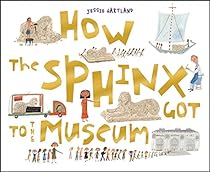How the Sphinx Got to the Museum (How the Got to the Museum)

| Author | : | |
| Rating | : | 4.24 (527 Votes) |
| Asin | : | 1609050320 |
| Format Type | : | paperback |
| Number of Pages | : | 40 Pages |
| Publish Date | : | 2014-06-07 |
| Language | : | English |
DESCRIPTION:
. Jessie Hartland is an illustrator, cartoonist, artist, packaging designer, and window display designer with a worldwide clientele. She is the author and illustrator of Clementine in the City and the illustrator of Messing Around on the Monkey Bars, The Perfect Puppy for Me and Drawing with Scissors. She lives with her family in New York City and Bellport, Long Island
E. R. Bird said Bit by bit, putting it together. One of the most frequent requests I get from parents in my library is a desire for books on "community workers". Which is to say, their children have been given an assignment in school on writing about the people who work in their neighborhood, and so we are charged with coming up with books about sanitation workers, doctors, bus drivers, etc. This being New York City, I always kind of wish that I'd get a request for a community worker a little out of the ordinary. How about a request for a book on a conservator? Or a museum registrar? Why do docents alw. "This is a fascinating glimpse at an unusual Egyptian pharaoh and how one of her sphinxes made it to the Met!" according to Deb. If you've are lucky enough to walk up the stairs and into the Metropolitan Museum of Art in New York City, you may have been able to see one of Hatshepsut's sphinxes. Hatshepsut was a pharaoh who ruled in ancient Egypt. There were many pharaohs and perhaps the most famous or memorable was King Tutankhamen, but Hatshepsut was undoubtedly the most unusual. Hatshepsut was a woman and that just wasn't supposed to happen in Egypt, but it did. There were "many monuments and pieces of art [that] were created in her honor." As with most pharaohs there were many . "A required read if you are going to visit the museum. And you should visit the museum." according to Philly Flower. This book helped me and my children to love the Met even more. The Sphinx is a beautiful statue but it is overshadowed by the huge Temple of Dendur looming over it. Now that we have read this book my kids love finding the little red numbers that identify it, and examine the parts of the statue that are real vs plaster. Did you know they intentionally make the plaster look different from the original so it's easier to tell the two apart? Because the Met has a room dedicated to Hatshepsut statues, this book helped us to value all of those works of art as w
It also includes vocabulary such as curator, rigger, and registrar, providing the opportunity to delve into discussions of unusual career choices, as well as fun verb choices that will intrigue children. . The accompanying illustrations are animated and detailed, from an archaeologist's tools to a curator's cluttered office—plenty for young eyes to discover and share. Hartland begins with a brief description of Hatshepsut and her significance as a female pharaoh in ancient Egypt, as well as explaining how most pharaohs had many pieces of statuary created in their honor. Grade 1–4—Lively ar
This is essential reading for junior Egyptologists!. Acclaimed author and illustrator, Jessie Hartland, beautifully presents this informative and fascinating history of the Hatshepsut sphinx: from its carving in ancient Egypt to its arrival in the hallowed halls of New York City’s Metropolitan Museum of Art
